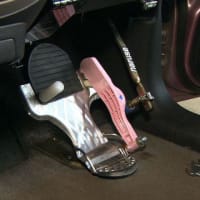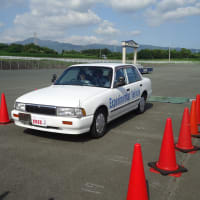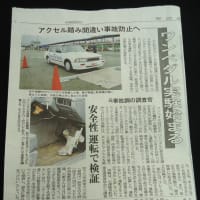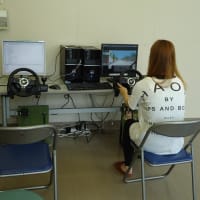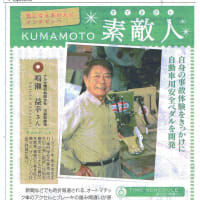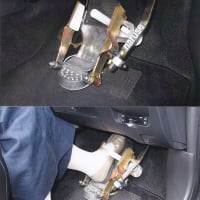
Gas-and-Brake Pedal Gets New Look After Recalls
Tyler Sipe for The New York Times
Masuyuki Naruse, right, in his factory in Tamana, Japan.
By HIROKO TABUCHI
Published: August 3, 2010
•
TAMANA, Japan — Two pedals, inches apart, one for gas and the other for brakes. For years, a Japanese inventor has argued that this most basic of car designs is dangerously flawed.
Related
• Most Carmakers Report Higher Sales(August 4, 2010)
Add to Portfolio
• Toyota Motor Corp
Go to your Portfolio »
The side-by-side pedal arrangement, the inventor says, can cause drivers mistakenly to floor the accelerator instead of the brakes, especially under stress. The solution? A single pedal that accelerates the car when pressed with the side of the foot. More to the point, when the pedal is pushed down, it always activates the brakes.
“We have a natural tendency to stomp down when we panic,” said the inventor, Masuyuki Naruse, who owns a small factory here in southwest Japan. “The automakers call it driver error. But what if their design’s all wrong?”
Mr. Naruse, 74, is one of a handful of people who have designed combined brake-accelerator pedals in an effort to prevent accidents caused by unintended acceleration, which has come under a spotlight since charges that some Toyota vehicles accelerate without warning.
Regulators in Sweden are testing a single-pedal prototype by the inventor Sven Gustafsson. In Japan, about 130 cars equipped with Mr. Naruse’s pedal, mostly owned by friends and acquaintances, have been declared street-legal, including Mr. Naruse’s own Mitsubishi Diamante sedan. He holds patents for the Naruse (pronounced NAH-roo-say) Pedal in Japan, the United States and six other countries.
Yasuto Ohama, a security company executive whose Toyota Harrier has one of the pedals, said he switched after his foot hit the gas instead of the brakes and he almost struck a bicyclist.
“I can never go back,” Mr. Ohama said. “I now have peace of mind, because there’s no mistaking when there’s only one pedal.”
Toyota, which attributes reports of unintended acceleration to gas pedals that stick or get caught under floor mats, has recalled 8.5 million vehicles worldwide to address the problems. It has also gently suggested that in some cases the driver might have been at fault.
Last month, it said that an internal investigation of 2,000 vehicles reported to have accelerated unintentionally found “pedal misapplication” in most cases, with drivers mistakenly pressing the accelerator instead of the brakes.
Ririko Takeuchi, a Tokyo-based spokeswoman for Toyota, said the company could not comment on Mr. Naruse’s pedal design. But she said Toyota “listens to ideas we receive from the public, because we believe there’s always room for improvement.”
“If you ask whether the current pedal design is the best we can do, the answer is no,” Ms. Takeuchi said.
Mr. Naruse’s pedal, in various versions, has been around for two decades. But until recently his testimonials fell mostly on deaf ears — despite many accidents linked to pedal confusion.
In 2009, nearly 6,700 traffic accidents involving 37 deaths and more than 9,500 injuries were thought to have been caused by drivers in Japan mistakenly pushing the accelerator instead of the brakes, said the Institute for Traffic Accident Research and Data Analysis, a government affiliated group based in Tokyo.
Car safety specialists say it is likely that tens of thousands of crashes in the United States have also been caused by pedal errors. In an accident in Santa Monica, Calif., in 2003, a driver believed to have hit the wrong pedal killed 10 people when his car plunged into an outdoor market.
Since at least the 1980s, researchers have pointed to the propensity for drivers to press the accelerator instead of the brakes. In a 1989 study, Richard A. Schmidt, a psychologist now at the University of California, Los Angeles, described how disruptions to neuromuscular processes can cause the foot to deviate from the intended motion, even slipping from the brake to the accelerator. And when the car accelerates unexpectedly, Mr. Schmidt said, even experienced drivers can panic, “braking” even harder.
In experiments in Japan by Katsuya Matsunaga, an engineering and psychology specialist at Kyushu Sangyo University in Fukuoka City, drivers were asked to switch feet from the accelerator to the brakes on cue, at times while accompanied by startling noises. Subjects under stress sometimes hesitated or found it difficult to switch from one pedal to the other, he said.
The current standard pedal arrangement is a function of automotive evolution.
Drivers of Ford’s 1908 Model T maneuvered an accelerator lever on the steering column and three pedals: for shifting gears, reversing and braking. Over time, the advent of various manual and automatic transmissions has required different footwork.
Mr. Naruse’s design is a unified pedal, shaped to accommodate the entire foot. On the right side is an accelerator bar. At any point, the driver can push down on the pedal to activate the brakes, while automatically releasing the accelerator bar.
In light of the recent Toyota recalls, the Obama administration has said it might require automakers to equip new cars with “smart pedals,” systems already used in some cars, that deactivate the accelerator when the brake pedal is pressed. But the smart pedals would not prevent drivers from pressing the gas pedal instead of the brakes.
“Simply speaking, the conventional pedal setup, which forces drivers to switch back and forth between pedals, is dangerous,” Mr. Matsunaga said.
“Mr. Naruse’s pedal works because it takes into account how our bodies work,” he said. “It makes sure that when we make a mistake, the car stops.”
Replacing standard pedals with the Naruse device requires no big changes to a car’s braking or acceleration systems, Mr. Naruse said, and retrofitting costs about 100,000 yen ($1,156) each. The biggest challenge of mass marketing the pedal, driving specialists said, would not be cost or technology, but the need to fundamentally change the way millions of people drive.
“For wider adoption, there would have to be solid proof that drivers used to the old pedal setup can adapt quickly and without error,” said Koya Kishida, who specializes in traffic psychology and ergonomics at Chukyo University in Japan.
Two episodes in the late 1980s, when Mr. Naruse hit the gas pedal instead of the brakes, inspired his quest for a better pedal. (He has invented other things, including a commercially successful machine that helps harvest edible seaweed). In one incident, his car lurched into a busy road, but he avoided a collision.
By 1991, he finished his first prototype. Mr. Naruse said Toyota engineers tested a prototype in 2000, but were dissatisfied with the design; the automaker would not comment, saying its research and development efforts were confidential.
Mr. Naruse said that in May he invited Akio Toyoda, president of Toyota, to try a Lexus sedan fitted with the latest version of his pedal. Mr. Naruse said he had received no response.
A version of this article appeared in print on August 4, 2010, on page A1 of the New York edition.

http://www.nytimes.com/2010/08/04/business/global/04pedal.html?pagewanted=all&_r=0
Tyler Sipe for The New York Times
Masuyuki Naruse, right, in his factory in Tamana, Japan.
By HIROKO TABUCHI
Published: August 3, 2010
•
TAMANA, Japan — Two pedals, inches apart, one for gas and the other for brakes. For years, a Japanese inventor has argued that this most basic of car designs is dangerously flawed.
Related
• Most Carmakers Report Higher Sales(August 4, 2010)
Add to Portfolio
• Toyota Motor Corp
Go to your Portfolio »
The side-by-side pedal arrangement, the inventor says, can cause drivers mistakenly to floor the accelerator instead of the brakes, especially under stress. The solution? A single pedal that accelerates the car when pressed with the side of the foot. More to the point, when the pedal is pushed down, it always activates the brakes.
“We have a natural tendency to stomp down when we panic,” said the inventor, Masuyuki Naruse, who owns a small factory here in southwest Japan. “The automakers call it driver error. But what if their design’s all wrong?”
Mr. Naruse, 74, is one of a handful of people who have designed combined brake-accelerator pedals in an effort to prevent accidents caused by unintended acceleration, which has come under a spotlight since charges that some Toyota vehicles accelerate without warning.
Regulators in Sweden are testing a single-pedal prototype by the inventor Sven Gustafsson. In Japan, about 130 cars equipped with Mr. Naruse’s pedal, mostly owned by friends and acquaintances, have been declared street-legal, including Mr. Naruse’s own Mitsubishi Diamante sedan. He holds patents for the Naruse (pronounced NAH-roo-say) Pedal in Japan, the United States and six other countries.
Yasuto Ohama, a security company executive whose Toyota Harrier has one of the pedals, said he switched after his foot hit the gas instead of the brakes and he almost struck a bicyclist.
“I can never go back,” Mr. Ohama said. “I now have peace of mind, because there’s no mistaking when there’s only one pedal.”
Toyota, which attributes reports of unintended acceleration to gas pedals that stick or get caught under floor mats, has recalled 8.5 million vehicles worldwide to address the problems. It has also gently suggested that in some cases the driver might have been at fault.
Last month, it said that an internal investigation of 2,000 vehicles reported to have accelerated unintentionally found “pedal misapplication” in most cases, with drivers mistakenly pressing the accelerator instead of the brakes.
Ririko Takeuchi, a Tokyo-based spokeswoman for Toyota, said the company could not comment on Mr. Naruse’s pedal design. But she said Toyota “listens to ideas we receive from the public, because we believe there’s always room for improvement.”
“If you ask whether the current pedal design is the best we can do, the answer is no,” Ms. Takeuchi said.
Mr. Naruse’s pedal, in various versions, has been around for two decades. But until recently his testimonials fell mostly on deaf ears — despite many accidents linked to pedal confusion.
In 2009, nearly 6,700 traffic accidents involving 37 deaths and more than 9,500 injuries were thought to have been caused by drivers in Japan mistakenly pushing the accelerator instead of the brakes, said the Institute for Traffic Accident Research and Data Analysis, a government affiliated group based in Tokyo.
Car safety specialists say it is likely that tens of thousands of crashes in the United States have also been caused by pedal errors. In an accident in Santa Monica, Calif., in 2003, a driver believed to have hit the wrong pedal killed 10 people when his car plunged into an outdoor market.
Since at least the 1980s, researchers have pointed to the propensity for drivers to press the accelerator instead of the brakes. In a 1989 study, Richard A. Schmidt, a psychologist now at the University of California, Los Angeles, described how disruptions to neuromuscular processes can cause the foot to deviate from the intended motion, even slipping from the brake to the accelerator. And when the car accelerates unexpectedly, Mr. Schmidt said, even experienced drivers can panic, “braking” even harder.
In experiments in Japan by Katsuya Matsunaga, an engineering and psychology specialist at Kyushu Sangyo University in Fukuoka City, drivers were asked to switch feet from the accelerator to the brakes on cue, at times while accompanied by startling noises. Subjects under stress sometimes hesitated or found it difficult to switch from one pedal to the other, he said.
The current standard pedal arrangement is a function of automotive evolution.
Drivers of Ford’s 1908 Model T maneuvered an accelerator lever on the steering column and three pedals: for shifting gears, reversing and braking. Over time, the advent of various manual and automatic transmissions has required different footwork.
Mr. Naruse’s design is a unified pedal, shaped to accommodate the entire foot. On the right side is an accelerator bar. At any point, the driver can push down on the pedal to activate the brakes, while automatically releasing the accelerator bar.
In light of the recent Toyota recalls, the Obama administration has said it might require automakers to equip new cars with “smart pedals,” systems already used in some cars, that deactivate the accelerator when the brake pedal is pressed. But the smart pedals would not prevent drivers from pressing the gas pedal instead of the brakes.
“Simply speaking, the conventional pedal setup, which forces drivers to switch back and forth between pedals, is dangerous,” Mr. Matsunaga said.
“Mr. Naruse’s pedal works because it takes into account how our bodies work,” he said. “It makes sure that when we make a mistake, the car stops.”
Replacing standard pedals with the Naruse device requires no big changes to a car’s braking or acceleration systems, Mr. Naruse said, and retrofitting costs about 100,000 yen ($1,156) each. The biggest challenge of mass marketing the pedal, driving specialists said, would not be cost or technology, but the need to fundamentally change the way millions of people drive.
“For wider adoption, there would have to be solid proof that drivers used to the old pedal setup can adapt quickly and without error,” said Koya Kishida, who specializes in traffic psychology and ergonomics at Chukyo University in Japan.
Two episodes in the late 1980s, when Mr. Naruse hit the gas pedal instead of the brakes, inspired his quest for a better pedal. (He has invented other things, including a commercially successful machine that helps harvest edible seaweed). In one incident, his car lurched into a busy road, but he avoided a collision.
By 1991, he finished his first prototype. Mr. Naruse said Toyota engineers tested a prototype in 2000, but were dissatisfied with the design; the automaker would not comment, saying its research and development efforts were confidential.
Mr. Naruse said that in May he invited Akio Toyoda, president of Toyota, to try a Lexus sedan fitted with the latest version of his pedal. Mr. Naruse said he had received no response.
A version of this article appeared in print on August 4, 2010, on page A1 of the New York edition.

http://www.nytimes.com/2010/08/04/business/global/04pedal.html?pagewanted=all&_r=0











